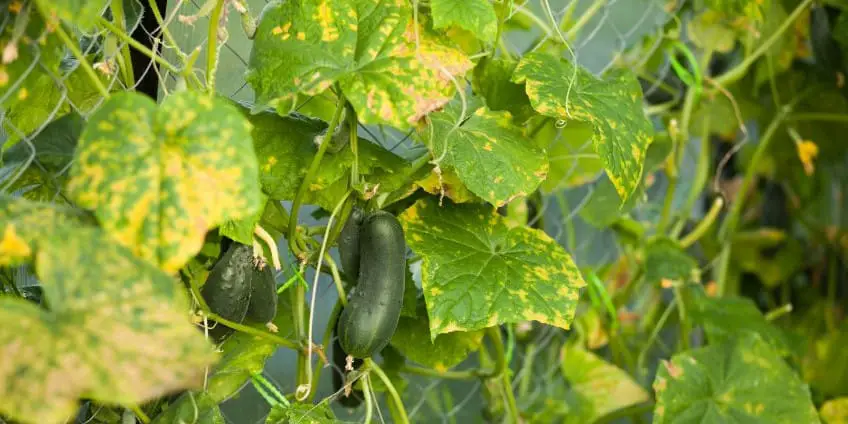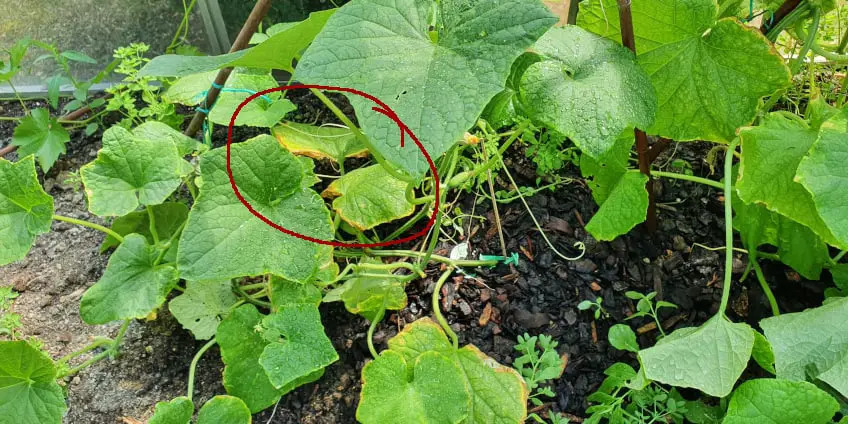
It is completely normal and very common that some of the leaves on your cucumber plants are turning yellow, but it also most likely means that there is an underlying problem that you should take care of. The first thing to consider is if you should remove the yellow leaves or leave them on the plant.
Cucumber leaves tend to turn yellow because of an underlying problem such as insects, diseases, poor soil, or something else and the best thing to do depends on the problem. If all the leaves are affected, you should not remove them but if only a few leaves are turning yellow, you can safely remove them.
The cause of cucumber leaves turning yellow is either isolated to some of the leaves or an issue with the whole plant. What you need to do and whether you should remove the affected leaves or not depends on the underlying problem.
Below, I explain a simple way to quickly figure out what to do in your specific situation and after that, I cover the seven most common underlying problems that cause cucumber leaves to turn yellow as well as how to fix them.
Yellow Cucumber Leaves: When to Remove Them and When Not To
Whether you should remove cucumber leaves that are turning yellow or not depends on a couple of things. The most important thing to consider is if the underlying reason why the leaves are turning yellow is a problem with the whole plant or if the problem is isolated to some of the leaves.
It is usually relatively easy to determine if the problem is isolated to some of the leaves or if the whole plant is affected.
If only a few leaves on your cucumber plant are yellowing but the rest of the leaves and plant look good, remove the affected leaves. If all the leaves are turning yellow, do not remove them. In that case, you need to identify and solve the underlying problem to save the whole plant.
So a good rule of thumb is: If one or a few leaves are yellow, remove them. If all the leaves seem to be affected, do not remove them.
Yellowing cucumber leaves are most often caused by an underlying problem that affects the whole plant, rather than just a few leaves. In those cases, the plant will look similar to the one in the photo a bit earlier in this article.
That said there are also several things that can cause one or a few leaves to turn yellow while the rest of the leaves look fresh and green. In these cases, you can safely remove the yellow leaves if not too many are affected. It will look similar to my plant in this photo but the yellowing can also be more severe. Notice how some of the leaves in the back are turning yellow and brown while almost all the other leaves look perfectly fresh and green.

In either case, if some of the leaves are turning brown or feel wet and soggy to the touch, you should remove them.
The best thing you can do to be sure is to figure out what the underlying problem is. I cover the seven most common reasons why cucumber leaves turn yellow now.
Why Your Cucumber Leaves Are Turning Yellow and What to Do
There are several potential reasons why the leaves on cucumber plants can turn yellow. Some of the reasons are very simple and easy to fix, but other reasons can be very complicated, and the best thing to do might be to remove the plant entirely. But let’s first see if there is a better solution.
Here are the seven most common reasons why cucumber leaves turn yellow with an explanation of how to fix each of the problems.
Overwatering
Overwatering is one of the most common problems people have when they grow cucumbers and is also one of the most common causes of cucumber leaves turning yellow. Overwatering causes damage to the roots, which means that it damages the whole plant and not just some of the leaves.
When you overwater your cucumbers, the excess water causes the oxygen level in the soil to be too low, which prevents the plant from obtaining the nutrients it needs. One of the effects of this is yellowing leaves.
To save overwatered cucumbers, you have to water them less. Always allow the top of the soil to dry out before you water the plant and if possible, move it to a place where it gets more direct sunlight. For potted cucumbers, bottom watering is another good way to reduce the risk of overwatering.
Cucumbers need moist soil, so wait for the top of the soil to become dry before you water them again, but don’t wait for much longer than that. If the soil gets dry all the way through, the plants might die.
A good way to reduce the risk of overwatering potted cucumber plants is to water them from the bottom. I explain how to do it, why it is a good idea to do it, and how it reduces the risk of overwatering in the article on this link.
The plant is near the end of its lifecycle
Cucumbers are annual plants, which means that they only live for up to one year, so the leaves will always begin to turn yellow and brown when the plant begins to die back in the fall or winter, depending on where you live. You can read more about that as well as some tips for keeping cucumbers alive for as long as possible on this link.
So if the temperature outside is starting to get colder because the growing season is coming to an end, the yellowing of the leaves on your cucumber plants might not be caused by any issue other than the fact that they are nearing the end of their lifecycle.
If this is the reason why your cucumber leaves are turning yellow, you will most likely notice more and more leaves turning yellow until the whole plant is turning yellow and brown and starting to die back.
In this case, the plants will usually also stop growing entirely, but there are several other things that can cause that to happen, which you should be aware of. You can read more about that in the article on this link.
Cucumbers growing on the ground instead of on a trellis
A lot of people, myself included, prefer to grow cucumbers on a trellis, but you can also grow cucumbers perfectly fine without a trellis by just letting them sprawl on the ground.
One of the disadvantages of growing cucumbers on the ground like that is that a large part of the plant, including most of the fruit, is in direct contact with the soil. This increases the risk of several issues including mold, slugs and other pests, and more, some of which can cause parts of the plant to turn yellow. The fruit also tends to become yellow on the parts that were touching the ground.
There are a lot more advantages to growing cucumbers on a trellis, but also some advantages to not using one. I have written this article, where I compare the advantages of both methods.
Poor soil causing a nutrient deficiency
Cucumber plants need well-draining, nutrient-rich soil to thrive. If the soil doesn’t drain well, the plants can become overwatered, which I covered earlier. If the soil doesn’t contain the right nutrients, or not enough of them, the plants will also show signs of it. A common sign is yellowing leaves, often starting with the lower leaves and then moving upwards.
I have written another article, where I go into depth with how to create the best soil mix for cucumbers as well as how to check if your soil is good enough and how to improve it if it isn’t. You can find the article on this link.
Insufficient sunlight and low temperatures
Cucumbers are tropical vegetables so they need high temperatures and a lot of sunlight to thrive.
If buildings or other plants are casting shade on your cucumber plants, they might not be getting the sunlight they need. If that is the case, it can be a good idea to move your cucumbers somewhere else where they get more direct sunlight.
It is limited what you can do to change the temperature, but something I have found to work really well is to grow your cucumbers in a greenhouse. A greenhouse will keep the plants warm for longer, which ultimately means that you can harvest more fruit from them.
A greenhouse has its advantages but there are also advantages to growing your cucumbers outside. I have made a comparison of the advantages of the two methods, which you can find here
Diseases
Cucumber plants can be infected by several different diseases and one of the common signs that your plants are infected with something is yellowing leaves.
The two most common diseases that can cause cucumber leaves to turn yellow are downy mildew and mosaic virus. They look slightly different but they both cause yellow spots to appear on the leaves, which become more and more yellow as the diseases spread.
The best thing you can do if your cucumber plants are infected with downy mildew or mosaic virus is to pull up the plant and destroy it as soon as possible to prevent the problem from spreading to other plants.
Insect damage
There are several different types of insects that can attack your cucumber plants. One of the most common signs that your plants are under attack is that the leaves turn yellow.
Some insects can be seen crawling around the leaves (although you might need a magnifying glass to see some of them) and some of them are underground, attacking the roots. Both can cause the leaves to turn yellow, either because the insects damage the roots, which prevents the plant from obtaining nutrients or because they suck the sap out of the leaves.
Common insects that attack cucumber plants include aphids, whiteflies, and spider mites.
A good trick to get rid of insects that I learned from a very experienced gardener I know is to use some all-natural soap mixed with water and spray it on the plant as well as on the ground around the plant. Use plenty.
For potted plants, it works excellently to sink the whole pot including the plant into the soap-water mix. Hold the pot and plant underwater for some time to allow the water to get everywhere in the soil to make sure you kill all the insects and eggs. I usually just hold it underwater until no more bubbles come up.
Make sure to spray the plant with water afterward to wash the soap away.
